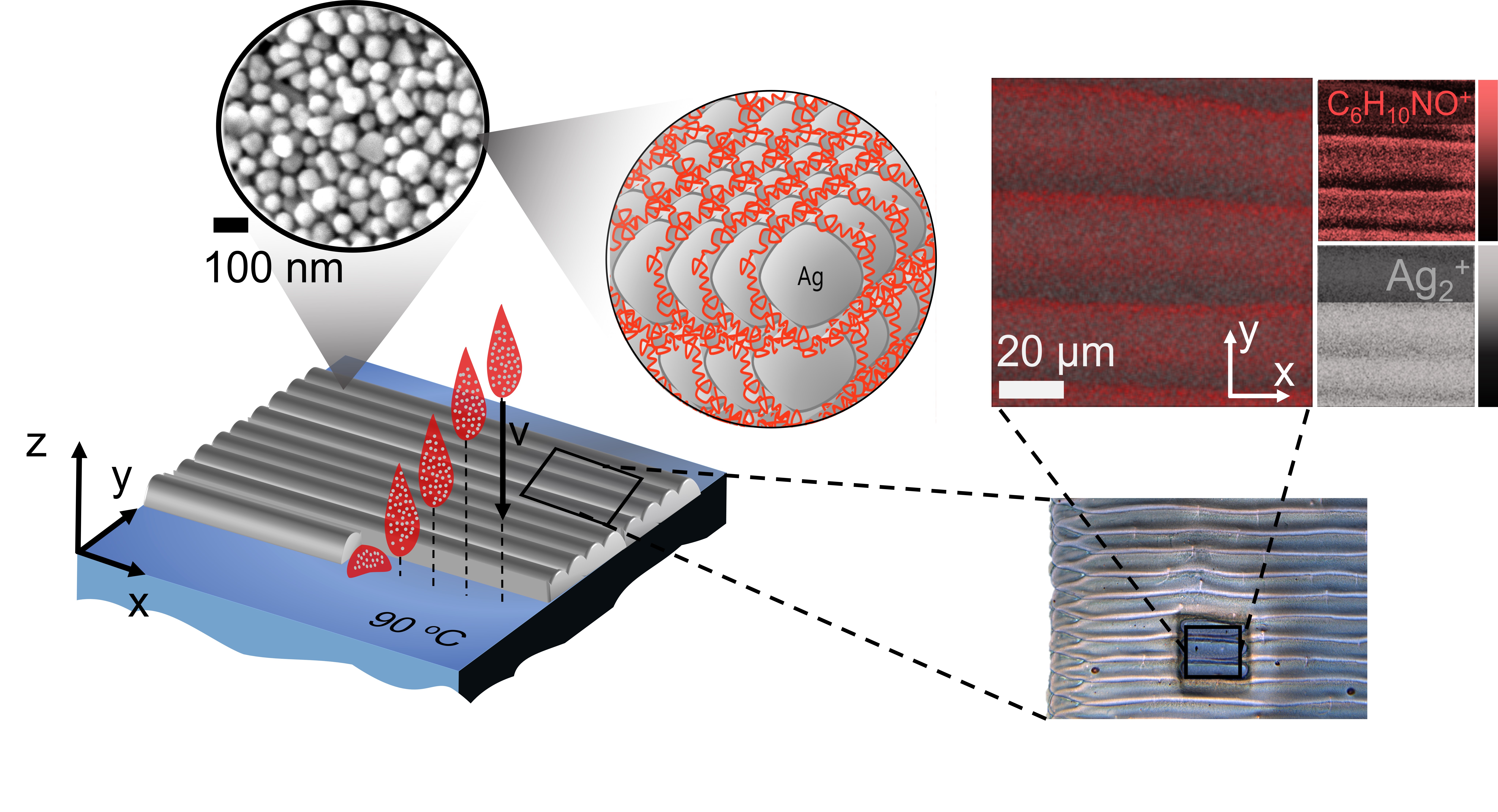Tuesday, 11 May 2021
Very thin layers of organic stabiliser residue in metal nanoparticle (MNP) inks are behind a loss of conductivity in 3D printed materials and electronic devices, according to the findings of a new study by the University of Nottingham and the National Physical Laboratory.
Inks containing metal nanoparticles are among the most commonly-used conductive materials for printed electronics. Ink-jetting layers of MNP materials allows for unpreceded design flexibility, rapid processing and 3D printing of functional electronic devices such as sensors, solar panels, LED displays, transistors and smart textiles.
Inkjet 3D printing of metals typically form a solid printed object via a two-step process: solvent evaporation upon printing (pinning) and subsequent low-temperature consolidation of nanoparticles (sintering). The low temperature is important as in many applications the nanoparticles are co-printed with other functional/structural organic materials that are sensitive to higher temperatures.
However, layers produced by inkjet printing of metal nanoparticles have different electrical conductivity between horizontal and vertical directions. This effect is known as functional anisotropy and is a long-standing problem for the 3D printing of functional electronic devices, preventing its use for advanced applications.
It was previously thought that reduced vertical conductivity through a printed device is mainly caused by shape and physical continuity problems at the interfaces of the constituent nanoparticles (at the very small micro and nanoscale). However, Nottingham researchers used silver nanoparticles to show, for the first time, that it is caused by organic chemical residues in the inks.
These residues, which are added to the inks to help stabilise the nanomaterials, lead to the formation of low-conducting, very thin nanoscale layers which interfere with the electrical conductivity of the printed sample in the vertical direction.
With a clearer understanding of the distribution of residual organic additives within printed layers, the researchers hope to go on to define new techniques and develop new ink formulations to overcome functional anisotropy of inkjet-based 3D printed electronics.
Lead author, CfAM Research Fellow Dr Gustavo Trindade, said, "The conductivity of inkjet-printed metal nanoparticles is known to be dependent on processing temperature and have been previously attributed to changes in the shape and porosity of clustered nanoparticles, with the role of organic residues being only speculated."
"This new insight enables the development of routes to overcome functional anisotropy in inkjet-based nanoparticles, and will therefore improve uptake of this potentially transformational technology, making it competitive with conventional manufacturing. Our approach is transferable to other nanomaterial-based inks including those containing graphene and functionalised nanocrystals, and will enable the development and exploitation of both 2D and 3D printed electronics like flexible and wearable sensors, solar panels, LED displays, transistors and smart textiles."
 (left) Digital inkjet printing of inks containing metal nanoparticles with in-situ solvent evaporation (pinning). (right) Optical and chemical images of a printed layer of silver nanoparticles showing organic residues at the surface
(left) Digital inkjet printing of inks containing metal nanoparticles with in-situ solvent evaporation (pinning). (right) Optical and chemical images of a printed layer of silver nanoparticles showing organic residues at the surface
The study was carried out by the Centre for Additive Manufacturing (CfAM), under the £5.85m EPSRC-funded Programme Grant, Enabling Next Generation Additive Manufacturing. Their findings are published in a new paper ‘Residual polymer stabiliser causes anisotropic electrical conductivity during inkjet printing of metal nanoparticles’ in the Nature journal Communications Materials.
The researchers used the unique chemical sensitivity of a state-of-the-art 3D orbiSIMS instrument owned by the University of Nottingham. The Nottingham orbiSIMS - the only one at a UK university - allows label-free 3D chemical imaging of materials with very high resolution, revealing insights that have informed this study.
Story credits
For a copy of the paper and media interviews contact Dr Gustavo Trindade on G.FerrazTrindade@nottingham.ac.uk, or Emma Lowry Media Relations Manager (Engineering) on 0115 846 7156 or emma.lowry@nottingham.ac.uk
Notes to editors:
About the University of Nottingham
Ranked 97 in the world and 17th in the UK by the QS World University Rankings, the University of Nottingham is a founding member of Russell Group of research-intensive universities. Studying at the University of Nottingham is a life-changing experience, and we pride ourselves on unlocking the potential of our students. We have a pioneering spirit, expressed in the vision of our founder Sir Jesse Boot, which has seen us lead the way in establishing campuses in China and Malaysia - part of a globally connected network of education, research and industrial engagement.
Nottingham was crowned Sports University of the Year by The Times and Sunday Times Good University Guide 2024 – the third time it has been given the honour since 2018 – and by the Daily Mail University Guide 2024.
The university is among the best universities in the UK for the strength of our research, positioned seventh for research power in the UK according to REF 2021. The birthplace of discoveries such as MRI and ibuprofen, our innovations transform lives and tackle global problems such as sustainable food supplies, ending modern slavery, developing greener transport, and reducing reliance on fossil fuels.
The university is a major employer and industry partner - locally and globally - and our graduates are the third most targeted by the UK's top employers, according to The Graduate Market in 2024 report by High Fliers Research.
We lead the Universities for Nottingham initiative, in partnership with Nottingham Trent University, a pioneering collaboration between the city’s two world-class institutions to improve levels of prosperity, opportunity, sustainability, health and wellbeing for residents in the city and region we are proud to call home.
More news…